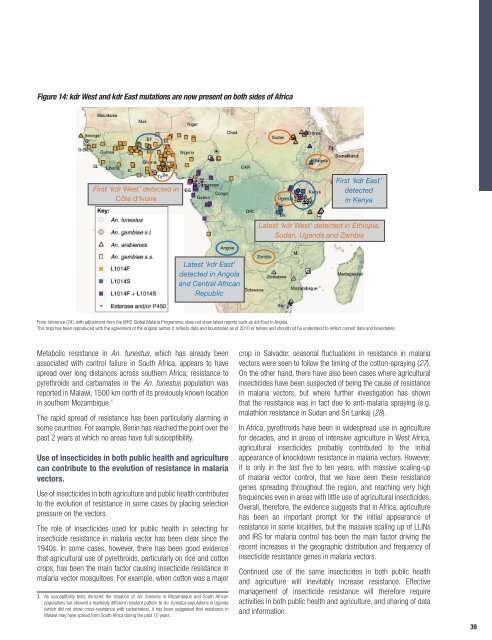Global plan for insecticide resistance management in malaria vectors
Global plan for insecticide resistance management in malaria vectors
Global plan for insecticide resistance management in malaria vectors
- No tags were found...
You also want an ePaper? Increase the reach of your titles
YUMPU automatically turns print PDFs into web optimized ePapers that Google loves.
Figure 14: kdr West and kdr East mutations are now present on both sides of AfricaFirst ‘kdr West’ detected <strong>in</strong>Côte d’IvoireFirst ‘kdr East’detected<strong>in</strong> KenyaLatest ‘kdr West’ detected <strong>in</strong> Ethiopia,Sudan, Uganda and ZambiaLatest ‘kdr East’detected <strong>in</strong> Angolaand Central AfricanRepublicFrom reference (24), with adjustment from the WHO <strong>Global</strong> Malaria Programme; does not show latest reports such as kdr East <strong>in</strong> Angola.This map has been reproduced with the agreement of the orig<strong>in</strong>al author. It reflects data and boundaries as of 2010 or be<strong>for</strong>e and should not be understood to reflect current data and boundaries.Metabolic <strong>resistance</strong> <strong>in</strong> An. funestus, which has already beenassociated with control failure <strong>in</strong> South Africa, appears to havespread over long distances across southern Africa; <strong>resistance</strong> topyrethroids and carbamates <strong>in</strong> the An. funestus population wasreported <strong>in</strong> Malawi, 1500 km north of its previously known location<strong>in</strong> southern Mozambique. 1The rapid spread of <strong>resistance</strong> has been particularly alarm<strong>in</strong>g <strong>in</strong>some countries. For example, Ben<strong>in</strong> has reached the po<strong>in</strong>t over thepast 2 years at which no areas have full susceptibility.Use of <strong><strong>in</strong>secticide</strong>s <strong>in</strong> both public health and agriculturecan contribute to the evolution of <strong>resistance</strong> <strong>in</strong> <strong>malaria</strong><strong>vectors</strong>.Use of <strong><strong>in</strong>secticide</strong>s <strong>in</strong> both agriculture and public health contributesto the evolution of <strong>resistance</strong> <strong>in</strong> some cases by plac<strong>in</strong>g selectionpressure on the <strong>vectors</strong>.The role of <strong><strong>in</strong>secticide</strong>s used <strong>for</strong> public health <strong>in</strong> select<strong>in</strong>g <strong>for</strong><strong><strong>in</strong>secticide</strong> <strong>resistance</strong> <strong>in</strong> <strong>malaria</strong> vector has been clear s<strong>in</strong>ce the1940s. In some cases, however, there has been good evidencethat agricultural use of pyrethroids, particularly on rice and cottoncrops, has been the ma<strong>in</strong> factor caus<strong>in</strong>g <strong><strong>in</strong>secticide</strong> <strong>resistance</strong> <strong>in</strong><strong>malaria</strong> vector mosquitoes. For example, when cotton was a major1 As susceptibility tests mirrored the situation of An. funestus <strong>in</strong> Mozambique and South Africanpopulations but showed a markedly different resistant pattern to An. funestus populations <strong>in</strong> Uganda(which did not show cross-<strong>resistance</strong> with carbamates), it has been suggested that <strong>resistance</strong> <strong>in</strong>Malawi may have spread from South Africa dur<strong>in</strong>g the past 10 years.crop <strong>in</strong> Salvador, seasonal fluctuations <strong>in</strong> <strong>resistance</strong> <strong>in</strong> <strong>malaria</strong><strong>vectors</strong> were seen to follow the tim<strong>in</strong>g of the cotton-spray<strong>in</strong>g (27).On the other hand, there have also been cases where agricultural<strong><strong>in</strong>secticide</strong>s have been suspected of be<strong>in</strong>g the cause of <strong>resistance</strong><strong>in</strong> <strong>malaria</strong> <strong>vectors</strong>, but where further <strong>in</strong>vestigation has shownthat the <strong>resistance</strong> was <strong>in</strong> fact due to anti-<strong>malaria</strong> spray<strong>in</strong>g (e.g.malathion <strong>resistance</strong> <strong>in</strong> Sudan and Sri Lanka) (28).In Africa, pyrethroids have been <strong>in</strong> widespread use <strong>in</strong> agriculture<strong>for</strong> decades, and <strong>in</strong> areas of <strong>in</strong>tensive agriculture <strong>in</strong> West Africa,agricultural <strong><strong>in</strong>secticide</strong>s probably contributed to the <strong>in</strong>itialappearance of knockdown <strong>resistance</strong> <strong>in</strong> <strong>malaria</strong> <strong>vectors</strong>. However,it is only <strong>in</strong> the last five to ten years, with massive scal<strong>in</strong>g-upof <strong>malaria</strong> vector control, that we have seen these <strong>resistance</strong>genes spread<strong>in</strong>g throughout the region, and reach<strong>in</strong>g very highfrequencies even <strong>in</strong> areas with little use of agricultural <strong><strong>in</strong>secticide</strong>s.Overall, there<strong>for</strong>e, the evidence suggests that <strong>in</strong> Africa, agriculturehas been an important prompt <strong>for</strong> the <strong>in</strong>itial appearance of<strong>resistance</strong> <strong>in</strong> some localities, but the massive scal<strong>in</strong>g up of LLINsand IRS <strong>for</strong> <strong>malaria</strong> control has been the ma<strong>in</strong> factor driv<strong>in</strong>g therecent <strong>in</strong>creases <strong>in</strong> the geographic distribution and frequency of<strong><strong>in</strong>secticide</strong> <strong>resistance</strong> genes <strong>in</strong> <strong>malaria</strong> <strong>vectors</strong>.Cont<strong>in</strong>ued use of the same <strong><strong>in</strong>secticide</strong>s <strong>in</strong> both public healthand agriculture will <strong>in</strong>evitably <strong>in</strong>crease <strong>resistance</strong>. Effective<strong>management</strong> of <strong><strong>in</strong>secticide</strong> <strong>resistance</strong> will there<strong>for</strong>e requireactivities <strong>in</strong> both public health and agriculture, and shar<strong>in</strong>g of dataand <strong>in</strong><strong>for</strong>mation.39
















